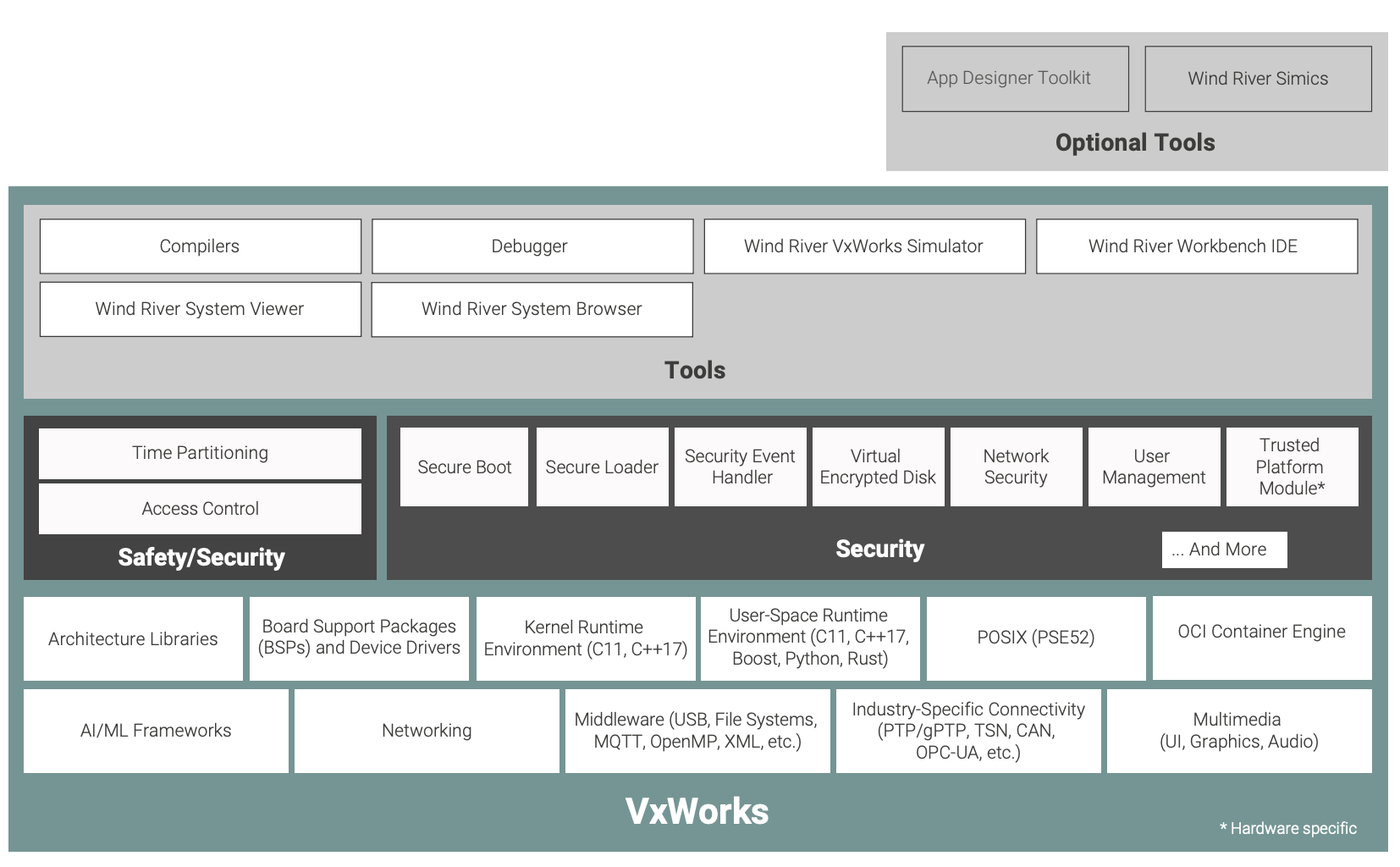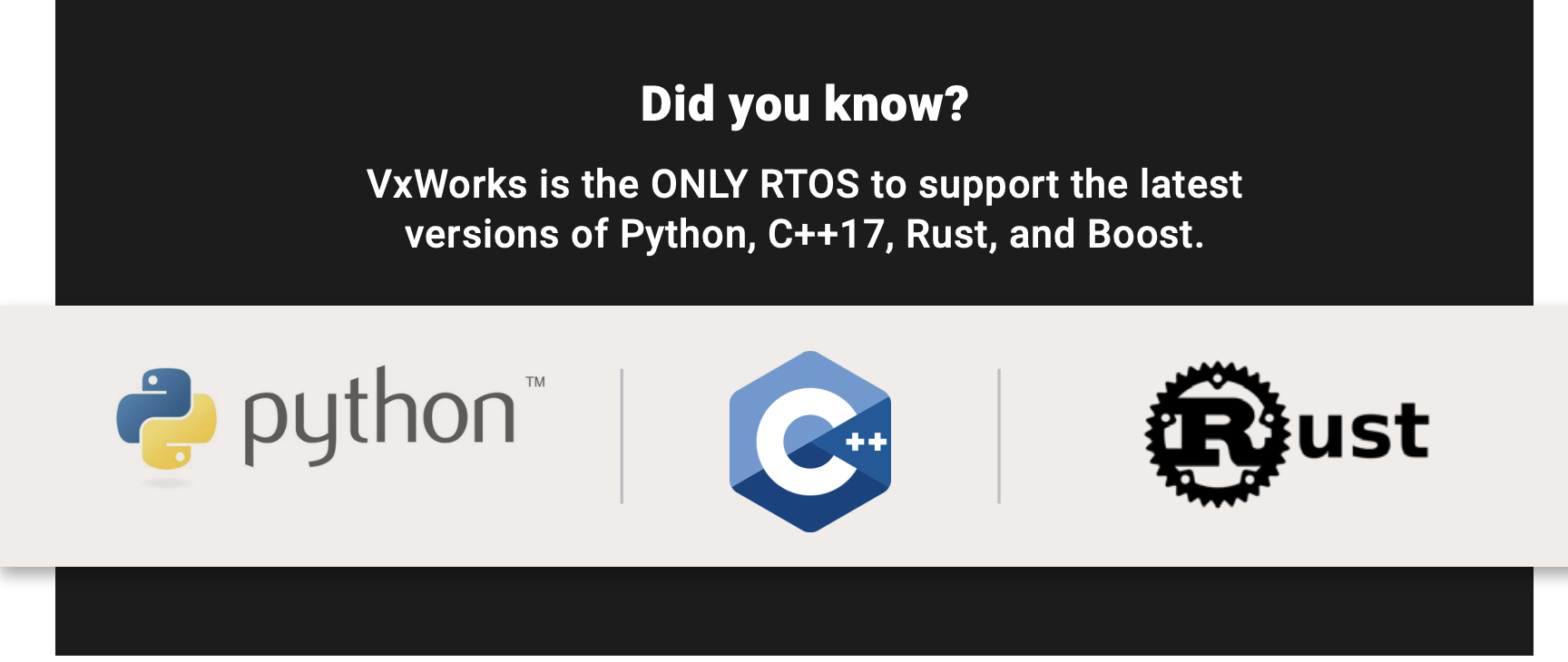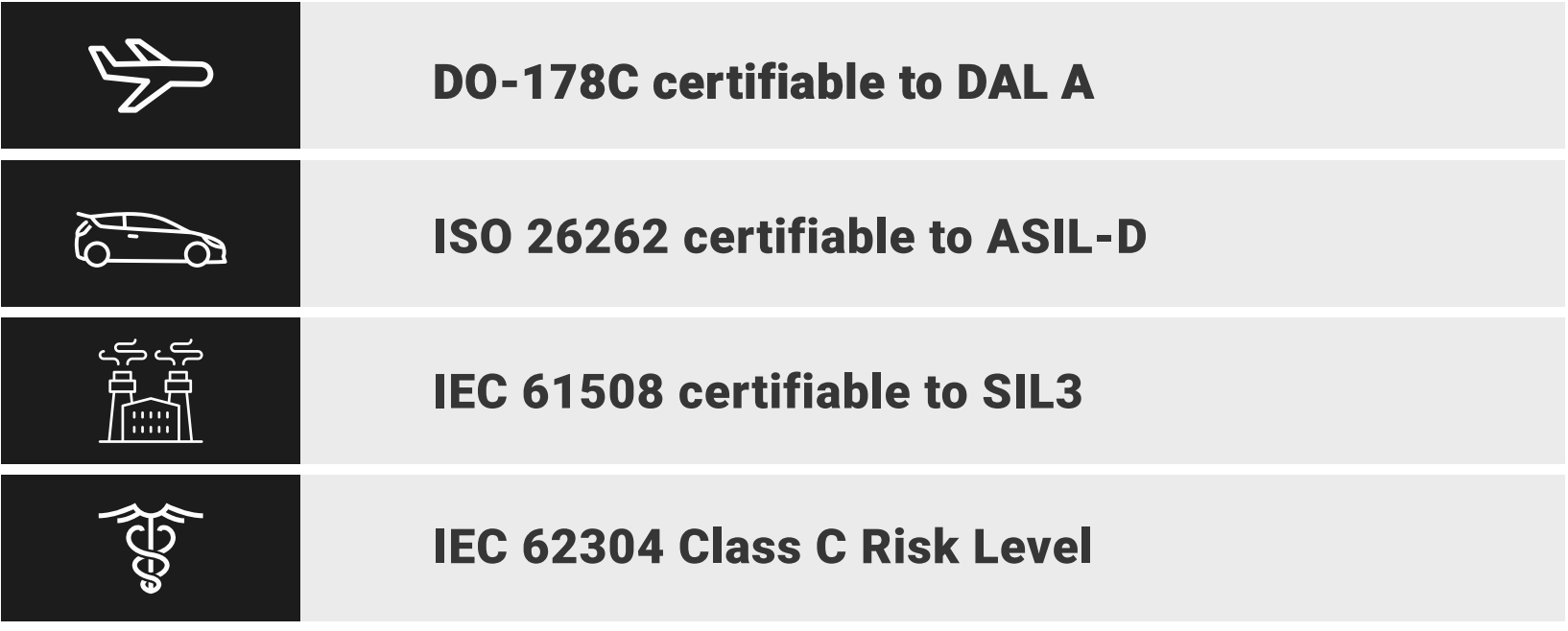VXWORKS
Redefining the Role of the RTOS
ABSTRACT
The world of embedded systems is undergoing a profound evolution. Once isolated and purpose-built, embedded systems are increasingly software-defined with much greater requirements for connectivity, reliability, and flexibility.
VxWorks® continues to lead this evolution with even greater capability, giving developers the power to be more productive and innovative. VxWorks enables embedded developers to take a modern approach to build nextgeneration embedded designs without compromising security, safety, reliability, and performance.
INTRODUCTION

The world of embedded systems is undergoing a significant evolution, affecting the role of the real-time operating system (RTOS) and the design of applications that rely on determinism, ultra-reliability, and performance. Once isolated and purposebuilt, embedded systems are rapidly adding new capabilities like greater connectivity, reusability, and flexibility. They’re increasingly software-defined. At the same time, the fundamental requirements of an RTOS have not changed. It still needs to be secure, safe, reliable, and certifiable.
VxWorks, the premier RTOS used to design ultra-reliable and mission-critical embedded systems across multiple industries, continues to lead the way with increased flexibility, performance, and speed of development. With VxWorks, makers of embedded systems can embrace new mainstream methodologies for development, improve hardware optimization, and maximize their investment in existing IP—all without compromising on reliability or performance.
BACKGROUND: THE ROLE OF THE RTOS IN EMBEDDED SYSTEMS
Embedded systems and the RTOSes they run are typically responsible for processes and machines of critical importance. This might be something as common as an elevator or as exotic as a Mars Rover. In many cases, the proper functioning of the RTOS ensures the protection of human lives and the environment. As a result, Wind River has always had four non-negotiable pillars for VxWorks.

THE CHANGING WORLD OF EMBEDDED SYSTEMS
The embedded systems world is changing rapidly. The pace of innovation is gaining momentum due to advances in technology and increased competition. Lower technology costs and shifts in business models further accelerate this evolution as information technology (IT) and operational technology (OT) systems begin to merge.

New Methodologies
Developers of embedded system software are moving to modern methodologies in search of greater efficiency, productivity, and portability. Both hardware and software development is moving faster than ever before.
New software engineers are coming into embedded systems with a high comfort level with abstraction and prefer to focus on the application rather than the underlying infrastructure. As a result, they want to build embedded systems using IT-like methodologies, programming languages, and frameworks. At the same time, engineers are leveraging low-cost hardware like the Raspberry Pi to build inexpensive prototypes and move quickly from concept to functioning device.
New Hardware and Virtualization
Rapid advances in multi-core-based hardware platforms enable the consolidation of systems and applications. With anywhere from 2 to 64 CPUs on a single chip, for example, it is possible to reduce the cost, size, and weight of the final product.
Virtualization is accelerating in embedded systems. Multiple embedded systems can now run, in virtualized form, on a hypervisor on top of a single piece of hardware.
Legacy Systems
This combination of increased performance, more connectivity, faster design cycles, and rapid innovation in components is making even relatively new products obsolete.
This raises the question of what to do with legacy systems. It’s not financially viable to recode embedded system applications over and over as platforms quickly evolve and system requirements change. System makers naturally want to reuse existing code as much as possible. These legacy systems still work but need to be modernized with new capabilities. And the significant investment already made to certify software needs to be preserved as code migrates to new hardware systems.

THE RESULTING PRESSURES ON RTOSES

Changing expectations for embedded systems cascade down to the operating systems that power them. Today’s RTOSes must keep pace with innovation and embrace modern development practices. They have to be able to work with new, more complex processors. Their design should enable the new, faster development cycles in the industry. This means being compatible with the frameworks, languages, and methodologies being embraced by the new generation of embedded system developers. Today’s RTOSes must work with virtualization and still meet all of these new criteria without any compromises to security, safety, performance, and reliability.
VXWORKS: LEADING THE WAY
The current generational shift in embedded systems and the RTOS is only the latest in the successful and impressive career of VxWorks. VxWorks has been the leading RTOS in aerospace & defense, automotive, industrial, medical, and other critical infrastructure sectors for more than 30 years. It’s the operating system behind nine different Mars missions, including the Mars Reconnaissance Orbiter as well as the Spirit and Opportunity Mars Exploration Rovers. It is also used in more than 2 billion other critical devices that are still on planet Earth. From automotive to manufacturing, if it’s a deterministic, ultra-reliable, or multi-core embedded system, VxWorks is the operating system of choice.
VxWorks is designed for multicore computing on embedded systems running on Arm, Intel, and Power architectures.

CODE: Create Once. Deploy Everywhere.

Wind River has embraced the charge toward platform independence for embedded systems. The vision of “Create Once. Deploy Everywhere” is getting closer to reality. Applications on VxWorks are easily managed and flexible. Developers can move their code from one platform to another as requirements shift since the logic is independent of the platform.
CODE: Create Once. Deploy Everywhere.
Alignment with New Frameworks
Updates to VxWorks include switching to a more open profile that now aligns more closely with modern approaches to application development.
There is a new C runtime environment available for VxWorks, as well as new development programming languages, frameworks, and compiler capabilities made possible by leveraging LLVM/Clang. These include support for Python, C++17, Rust, and Boost.
Python is known for its simplicity and is, therefore, used for a range of applications, including data science. Prototyping an application in Python is relatively easy, which suits the new, fast-tracked development that is common in the embedded systems industry. Python is also considered a great solution for writing the networking portion of an embedded system.
Rust is suitable for higher-level concepts in embedded systems, particularly those that require a safety guarantee. To this point, Rust features a robust concurrency model that guarantees no two threads will share the same state during runtime. The language also provides for flexible memory management. Developers can allocate memory in Rust on a dynamic or static basis. From a developer management perspective, Rust has the further advantage of easy integration into existing C or C++ codebases. Rust developers can port their embedded system code easily across a wide range of systems.

VxWorks Performance Enhancements
VxWorks is adding new performance capabilities to meet and exceed the expectations of embedded system architects. For instance, network throughput is now on a par with, or better than, what is possible with Linux.
VxWorks is also updating its ability to deal with Interrupt Service Routine (ISR) spinlock. The kernel-defined spinlock is a synchronization mechanism that protects shared data or resources from being used or accessed simultaneously by concurrently executed routines. With ISR spinlocks, VxWorks has been optimized to ensure smooth, expected performance from essential functions regardless of potentially conflicting routines.
On a similar front, VxWorks is reducing interrupt jitter on Intel architecture (IA) for TimeSensitive Networking (TSN) applications. System interrupts can cause jitter in the RTOS. This deprecates the effectiveness of the RTOS and can disturb its proper functioning for an embedded system. Overall, VxWorks is reducing TSN jitter at the level of sub 2µs.
VxWorks can work with Open Multi-Processing (OpenMP), an API that consists of library routines, compiler directives, and other environment variables. This allows customers to leverage the solution to improve the performance of their applications and enables parallelism between nodes and clusters—speeding up embedded system performance in the process. The OpenMP API supports multi-platform shared-memory and multi-processing programming in languages such as C++ and C on platforms like Linux, Mac, AIX, HP-UX, Windows, and now, VxWorks.

Virtualization and Legacy Support
Virtualization will be playing a prominent role in embedded systems design and deployment in the near future. The Wind River Helix™ Virtualization Platform speaks to this new and rapidly evolving set of requirements.
VxWorks is the cornerstone OS for Helix Platform, which is designed to facilitate the demanding security, safety, reliability, and certification requirements of virtualized embedded systems. Helix Platform enables the consolidation of multiple embedded computing operating systems onto a single device.
What’s more, Helix Platform provides the ideal solution as to what to do with legacy systems. Helix Platform can support any embedded operating system and the applications running on top of them. This enables manufacturers to maximize their investments in existing IP while providing a bridge for those applications to new platforms.

Security Enhancements for VxWorks
Wind River has actively engaged in building more security capabilities into VxWorks. These range from support for security standards to OS-level countermeasures. Each reflects the distinctive and extremely challenging risk protection needed for embedded systems. For instance, as embedded systems are more likely to be connected to remote devices, VxWorks has bolstered its security for remote operations cryptography and so forth. Highlights of recent VxWorks security improvements include:
- Arm® TrustZone OP-TEE support: Arm TrustZone technology delivers systemwide hardware isolation for trusted software, integrated into an Arm Cortex-A core processor. VxWorks now enables the establishment of a Trusted Execution Environment (TEE) in this usage context. The TEE protects embedded systems running VxWorks against attackers through an additional layer of security where code/data running on the TEE cannot be accessed or tampered with from the outside “normal” world, such as a Linux- or Android-based applications.
- GE Digital® Achilles Level II Certification for compliance with IEC 62443-4-2: GE Digital’s Achilles System Certification (ASC) program enables control system vendors to illustrate how their products comply with the IEC 62443-3-3 standard’s cybersecurity requirements. Now, vendors using VxWorks can demonstrate this compliance.
- Secure Boot/Secure Loader: As security is becoming increasingly important, so is the need to ensure that the right firmware and applications are running. With secure boot and support for a secure loader, VxWorks images and applications of all types can be digitally signed and, optionally, encrypted. With a hardware backed white-listing, you know only your code will run.
- Kernel page-table isolation (KPTI): KPTI was introduced into VxWorks to mitigate the Meltdown security vulnerability.
- OpenSSL FIPS 140-2 Module: Embedded systems sometimes need to conform to the Federal Information Processing Standard (FIPS) Publication 140-2. VxWorks now supports this standard for affected embedded systems.
- SSH client and server: SSH is a remote login protocol protected by cryptography. VxWorks supports SSH to enable secure management of remote servers that run embedded systems. This includes supporting current crypto algorithms.
New and Ongoing Certification
VxWorks has recently added significant new hardware compatibility. This includes support for Arm 64-bit and certification for Armv7. The expanding portfolio of certifications for VxWorks now encompasses:

New Hardware? New BSPs
Wind River has one of the most comprehensive collections of board support packages (BSPs) and we’re even offering a new BSP installation structure for VxWorks. BSPs include customized drivers and routines to enable VxWorks to run on a specific piece of hardware. One of the latest BSPs announced is the open source Raspberry Pi.

THE MOST INNOVATIVE RTOS
Wind River is committed to rapid and continuous innovation while remaining true to its roots around security, safety, reliability, and certifiability. VxWorks is the industry’s leading RTOS. It delivers all the requirements organizations need to meet the highest standards for running the computing systems of the most important critical infrastructure.

WIND RIVER LABS
Wind River also offers VxWorks developers access to innovative new technologies that include open source projects, pre-release features, and in-house engineering projects through Wind River Labs. Wind River Labs currently provides free access to VxWorks projects for OpenCV, ROS2, and software development kits for cloud platforms such as AWS, Azure, and Google. Access to bleeding-edge technologies and direct collaboration with Wind River engineers lets VxWorks customers innovate sooner.
ABOUT WIND RIVER
Wind River is a global leader in delivering software for the intelligent edge. The company’s technology has been powering the safest, most secure devices in the world since 1981 and is found in more than 2 billion products. Wind River offers a comprehensive portfolio supported by world-class global professional services and support and a broad partner ecosystem. Wind River software and expertise are accelerating the digital transformation of critical infrastructure systems that demand the highest levels of safety, security, and reliability.
WHEN CUSTOMERS NEED IT TO WORK AND WORK RIGHT, THEY CHOOSE WIND RIVER


